Bcs 948, 853, 852, 732, 718 User Manual
...
POWER UNITS
& Gardening Attachments
OWNERS
USE & CARE
MANUAL
CODE NUMBER 90103079 EDITION 11.17
M O D E L S NEW HANDLEBARS
710
718
GARDENER HARVESTER
722 HARVESTER
732 PROFESSIONAL
948 PROFESSIONAL
852 PROFESSIONAL
853 PROFESSIONAL
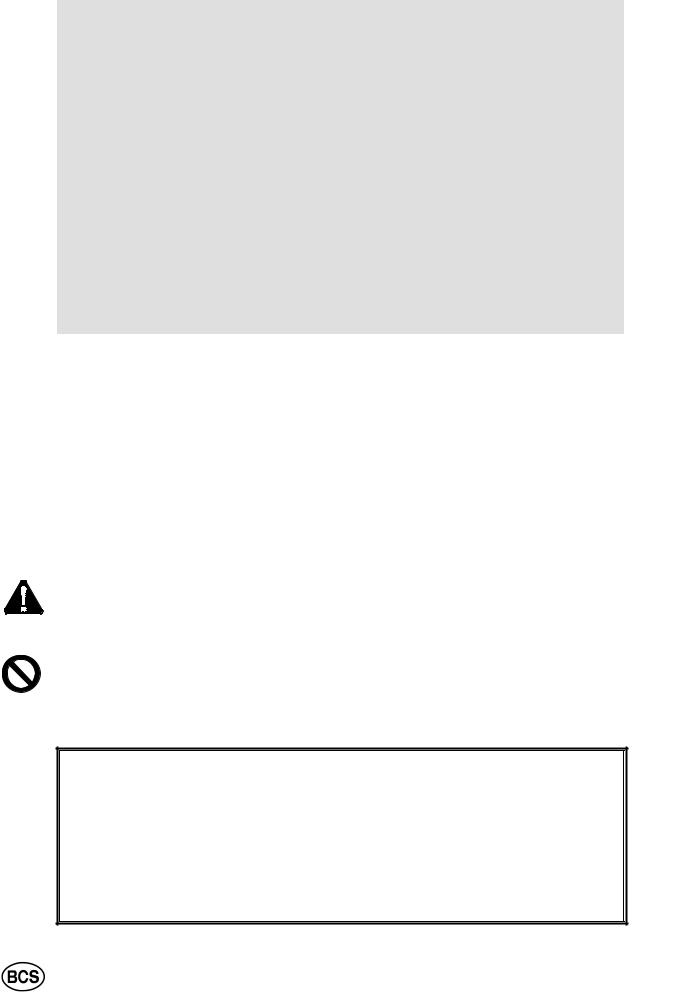
Dear Customer,
Thank you for your purchase. Get set to enjoy the benefits your wise selection of a BCS unit has earned for you. We believe that no other make machine that can handle so many lawn and garden tasks with such fine results – and with so little effort on your part.
Your BCS unit has precision gearing for lasting, trouble-free service. There are no drive belts to stretch and break.
Our network of BCS distributors and servicing dealers stands ready to supply tour needs for attachments, accessories, parts and service. With a yearly check-up, your dealer can help you keep your BCS equipment to shape. Meanwhile, be sure to follow the operating and maintenance tips in this owner’s manual for satisfied performance of your machine.
BCS America
MODELS IN THIS EDITION
BCS America maintains a dynamic updating policy. If notifies the field of the serial number of the first unit off the line after a change.
This edition covers the models and model options listed in the specifications on page 16.
Accordingly, be sure to record the BCS unit serial number printed between two stars on the transmission, and the engine model and serial numbers from the engine name plate.
GRAPHIC SYMBOL
THIS SYMBOL IS LIKE A FLAG.
IT FLAGS YOUR ATTENTION TO DANGER WARNINGS IN THE MANUAL.
WHEN PLACED OVER A PICTURE OR AN ITEM IN THE PICTURE, THIS SYMBOL SAYS “NO !” DO NOT DO, OR USE OR PERMIT WHATEVER IS SHOWN.
 WARNING
WARNING
READ ALL SAFETY RULES AND OPERATING AND MAINTENANCE
INSTRUCTIONS IN THIS MANUAL BEFORE USING ANY POWER UNIT,
ATTACHMENT, OR ACCESSORY.
2

CONTENTS
SECTION ONE
RULES FOR SAFE OPERATION OF UNIT AND ATTACHMENTS
GENERAL PRECAUTIONS AND INSTRUCTIONS
REAR-TINE TILLER PRECAUTIONS
ROTARY MOWER PRECAUTIONS CUTTER BAR MOWER PRECAUTIONS SNOW THROWER PRECAUTIONS POWER SPRAYER PRECAUTIONS CHIPPER/SHREDDER PRECAUTIONS POWER SWEPPER PRECAUTIONS
SECTION TWO
SCHEME CONFIGURATIONS
SECTION THREE
USE AND CARE OF ATTACHMENTS
MODELS DESIGNED FOR FRONT-MOUNTED ATTACHMENTS MODELS DESIGNED FOR REAR-MOUNTED ATTACHMENTS SPECIFICATIONS
MODEL 852, 853 MODELS 710 MODELS 718, 722, 732 MODEL 948
UNPACKING ASSEMBLING THE UNIT
LUBRICATION FILTER AND FUEL
ENGINE CRANKCASE LUBRICATION GEARBOX LUBRICATION
ENGINE AIR CLEANER GASOLINE ENGINE FUEL
STARTING AND STOPPING
SETTING CONTROLS FOR COLD STARTING CRANKING TO START
STOPPING
DIFFERENTIAL AND TWO-WHEEL DRIVE WHEEL BRAKES
SHUT-DOWN (STORAGE)
TAKING CONTROL OF THE MACHINE
GEAR AND P.T.O. ENGAGEMENT
MAKING A CONVERSION FRONT-TO-REAR, OR REAR-TO-FRONT
OPERATING IN CONVERTED MODE
MAINTENANCE PROGRAM
LUBRICATION OF ATTACHMENTS
COUPLING ATTACHMENT TO P.T.O. USE AND CARE OF REAR-TINE TILLER
PREPARING NEW TILLER WIDTH OF TILTH
TILLING DEPTH ADJUSTMENT
GARDENING SUGGESTIONS
TRANSPORT SULKY FOR REAR-TINE TILLER
USE AND CARE OF CUTTER BAR MOWER ATTACHMENT
GENERAL CUTTER BAR MOWER INFORMATION RECOMMENDED OPERATION
MOWER BAR MAINTENANCE
USE AND CARE OF 2-BLADE ROTARY MOWER
THE UNITS CONVERTED FOR MOWER USE
ASSEMBLY, CONNECTION AND LEVELING OF THE 2-BLADE MOWER LUBRICATION
ROTARY MOWER OPERATION INSPECTION AND MAINTENANCE
USE AND CARE OF SNOW THROWERS
GENERAL INFORMATION SNOW THROWER OPERATION
USE AND CARE OF CHIPPER / SHREDDER
CHIPPER / SHREDDER MAINTENANCE
USE AND CARE OF POWER SWEEPER
OPERATION
MAINTENANCE AND STORAGE
USE AND CARE OF DOZER BLADE
3
Page 5
“8
“9
“10
“10
“11
“12
“13
“15
“15
“16
“17
“18
“19
“20
“21
“21
“25
“25
“25
“26
“27
“28
“29
“30
“30
“30
“30
“31
“31
“31
“32
“33
“35
“36
“36
“37
“37
“37
“37
“38
“38
“39
“39
“39
“39
“41
“41
“41
“42
“42
“43
“44
“44
“44
“45
“45
“46
“46
“46
“47
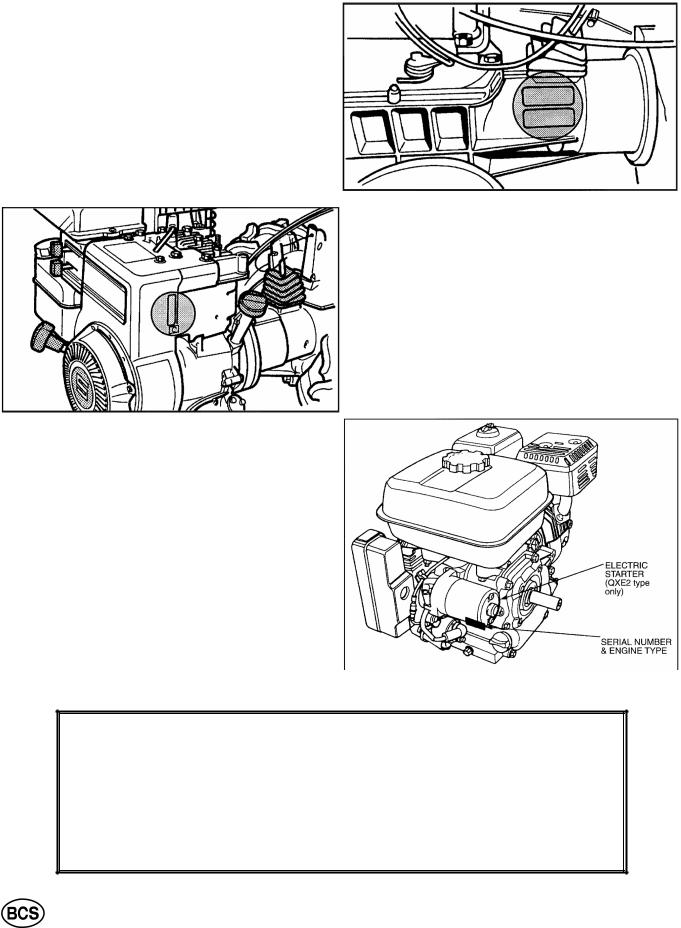
RECORD OF SERIAL NUMBERS .
BCS UNIT SERIAL NUMBER * __________ *
(Located between stars on transmission)
BRIGGS & STRATTON
ENGINE SERIAL NUMBER __________
(Stamped on crankcase about two inches from name plate on side of engine)
HONDA ENGINE SERIAL NUMBER:
TYPE _____________
SERIAL NO. ____________
KOHLER ENGINE SERIAL NUMBER ____________________ (Located on engine crankcase)
 WARNING
WARNING
READ ALL SAFETY RULES AND OPERATING AND MAINTENANCE
INSTRUCTIONS IN THIS MANUAL BEFORE USING ANY POWER UNIT,
ATTACHMENT, OR ACCESSORY.
4

SECTION 1
INSTRUCTIONS FOR SAFE OPERATION OF BCS POWER UNITS AND ATTACHMENTS
General precautions and instructions are followed by specific precautions for each combination of attachment and power unit in the owner’s manual.
GENERAL PRECAUTIONS AND INSTRUCTIONS
TRAINING
READ THIS OWNER'S MANUAL PRIOR TO OPERATING THE POWER UNITS AND ATTACHMENTS.
BCS power units and attachments are designed for operation by properly instructed adults only. Make certain that any person operating this equipment has read this manual.
DO NOT LET CHILDREN OPERATE THE POWER UNIT.
KEEP THE OPERATING AREA CLEAR OF PEOPLE AND ANIMALS. BE CAREFUL THAT CHILDREN DO NOT COME NEAR.
During storage, and whenever the power unit is unattended, disengage the PTO (power take-off) and render the engine unstartable by disconnecting the spark plug wire from spark plug.
PREPARATION
Wear appropriately protective clothing and safety protection articles for the climate and type of attachment you are to operate.
1.For all walk-behind applications, wear sturdy non-slip boots or safety toe shoes. See recommendations listed for use of a particular attachment. Do not wear open-toed sandals or go barefoot when operating these machines.
2.Wear snug-fitting protective clothing which allows freedom of movement without being loose-fitting. Ties, scarf and jewels which could be caught in the machinery should not be worn.
3.Wear hearing protection.
4.Wear eye protection when operating a snow-thrower, power sprayer, chipper / shredder or mower attachment.
5.Overexposure to sunlight can be damaging to your eyes and skin. When working in strong sunlight, protect your eyes with sun glasses and either keep your body covered or apply a sun screen lotion.
Do not operate on terrain where you cannot maintain good footing or where the machine could overturn or slide into you. When walking behind the unit, walk slowly. DO NOT RUN!
5

12
Thoroughly inspect the area where you are going to mow or thatch the lawn, sweep walks or drives or throw snow. Remove toys, stones, bones, wires, glass, newspapers and other objects which could be caught up and thrown by the machine. Take the following precautions for the safe handling and storage of fuel:
1.Keep fuel supplies in approved type, properly labelled fuel containers.
2.Do not store fuels or fuelled units in closed (unventilated) areas or in garages or shops connected to human living quarters. Do not store units or fuel where there are flames or sources of sparks such as electrical appliances and switches.
3.Obey all local regulations for the storage and handling of fuel.
4.Do not smoke when fuelling, or fuel where the fumes could be ignited by fire or sparks.
5.Do all fuelling outdoors over non-flammable surfaces. If fuel is spilled on the unit, wipe the unit dry and properly dispose of the wiping rag. ALWAYS MOVE THE UNIT AT LEAST 10 FEET (3 m.) AWAY from the fuelling spot and fuel supplies before starting the engine.
6.Always remove the engine fuel cap very slowly to equalize tank pressure and avoid spurting of fuel. Keep your face and eyes away from the tank while loosening the fuel cap.
7.Do not fuel a running or hot engine. Do not loosen the fuel cap until the engine has stopped.
Then wait several minutes for the engine to cool before pouring fuel. Before starting the engine, put all control levers in neutral (N) position. All "N" positions on the gear selector are neutral. Also be sure to disengage the PTO (power take-off) to the attachment. Never make blade height or any other adjustment to the power unit or any attachment while the engine is running.
OPERATION
Operate only when there is good visibility. Do not operate at dusk or at night. Do not operate when it is foggy or hazy.
Never change the engine governor setting or overspeed the engine. Use the throttle and gear settings recommended for particular attachments and applications in this owner's manual.
Do not put hands and feet under the mower deck or into the discharge openings of a rotary mower.
Do not put fingers or any other part of the body into the intake or discharge openings of any mower, snow-thrower or chipper/ shredder unless you have disconnected the spark plug wire so engine cannot be started accidentally.
Keep the machine clean-out holes closed. Stay out of the discharge stream of a mower, chipper/shredder, power sweeper or power sprayer.
Always stop operation of a rotary mower, a cutter bar mower, snow thrower or a tiller before crossing paved or gravel roadways.
6
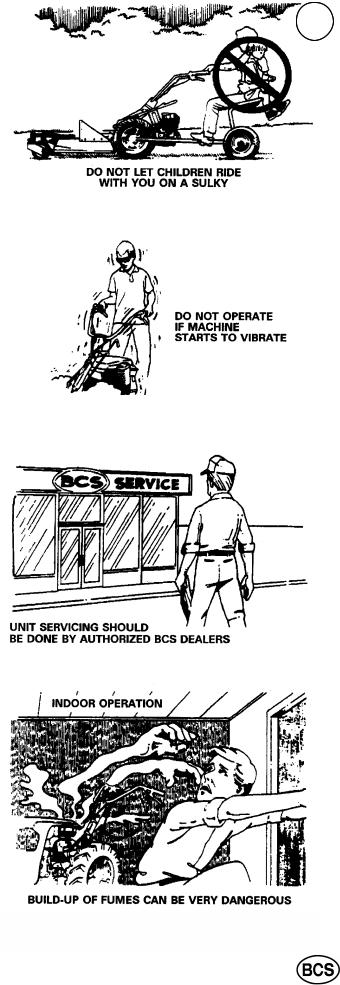
21
Never ride the tractor or an attachment. Ride only on riding accessories designed for the purpose. Do not take children on a sulky with you.
1.Use transport sulkies only for transport to and from the operating area and never for operation.
2.Use utility wagons only for hauling and limit the payload to the rated capacity of the wagon.
3.A mowing sulky is exclusively for operation of a rotary mower and must not be used with any other attachment.
4.Never use ride-on attachments on the highway or any city street.
Do not disconnect or otherwise defeat the purpose of the lockout devices.
The high-speed lockout prevents using too fast a gear for backing up a front-mounted attachment.
The PTO/REVERSE lockout permits backing up a rearmounted attachment only when the PTO is disengaged. Read Section Two for explanation of the lockout devices.
Do not use the highest numbered gear on the gear selector when walking behind the machine.
On all units in this manual, the highest gear produces much faster than walking speed and is only to be used for transport in conjunction with a transport sulky.
Don't make adjustments or repairs to the machine when the engine is running.
Put all controls in neutral, wait until reciprocating or rotating parts of the attachment have stopped and disconnect the spark plug wire:
1.Before leaving the unit where unauthorized persons may start it accidentally.
2.When a foreign object has been struck or taken into the attachment. Proper operation should be restored before further use.
3.Before cleaning out a clogged attachment such as a rotary mower, cutter bar mower, snow-thrower, chipper/ shredder or power sweeper.
4.If the machine suddenly starts to vibrate or run erratically. The entire machine should be inspected by an authorized BCS servicing dealer before further use.
All safety guards, plates, lockouts, deflectors and shields must be in proper position.
Do not operate if any safety devices or fastening parts are missing from the unit.
Do not run the engine indoors where deadly poisonous carbon monoxide fumes can collect.
If the engine is to be started inside a garage or barn, open the doors and windows wide so the fumes can escape.
7
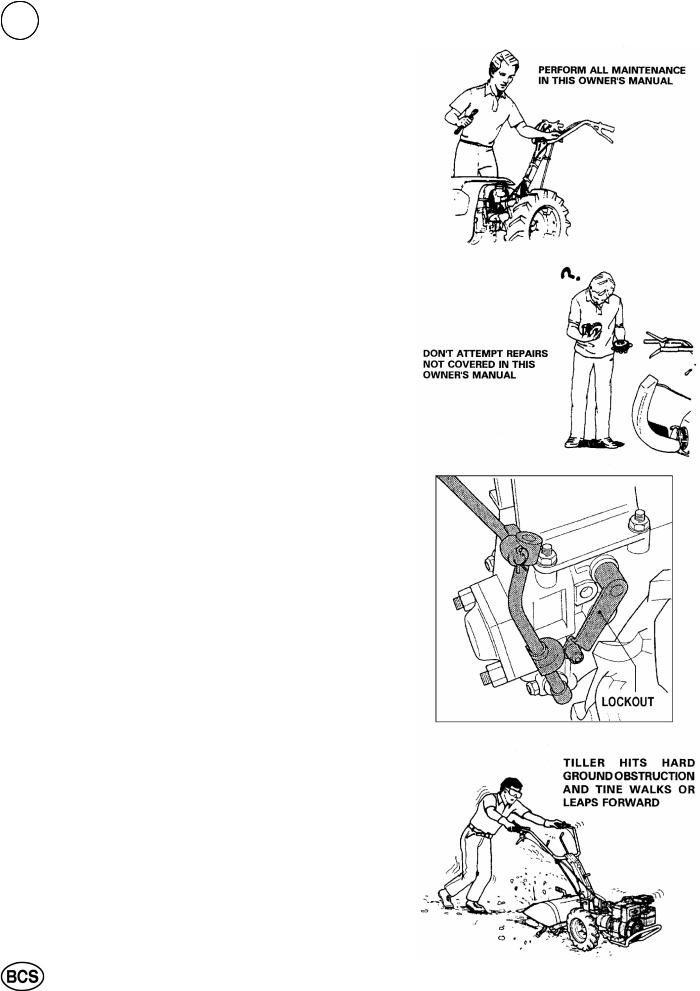
12
MAINTENANCE AND STORAGE
Keep engine, tractor and all attachments in safe working condition. Clean the unit and accessories at regular intervals, also check for damaged or missing parts.
Check the tightness of all fasteners. Perform the items of maintenance recommended in this owner’s manual. Do not attempt any disassembly and repairs for which instructions have not been furnished.
Certain engine adjustments, and interval servicing of the engine, tractor, clutch and transmission, and gearboxes of attachments should be done only by a BCS-trained service-man at an authorized BCS servicing dealer or distributor.
Do not store the machine with fuel in the system. Disconnect the fuel line at the carburettor inlet, and drain the fuel into a fuel container. Then reconnect the fuel line. Start and run the engine until it stops from lack of fuel.
When storing the machine, use the spring latch (illustrated on page 29) to latch the clutch lever in the depressed (disengaged) position. This prevents the clutch cone from sticking to the lining during storage.
Store the machine in a well-ventilated place, protected from dampness and the weather.
REAR-TINE TILLER PRECAUTIONS
All the models have PTO / reverse lockout devices to prevent tine rotation while the Tiller is being backed up. These devices are shown and their operation described on page 28. Before operating the Tiller, always check that the lockout device is properly assembled on the machine. Do not remove the high speed lockout or render it inoperable.
Don’t put hands or feet near or under the tiller housing. Keep away from the rotating tines. The tines of the BCS tiller rotate at high speeds independent of the tractor gear speed settings.
Inspect the area to be tilled. Pick up rocks and other objects of a size which may jam or otherwise interfere with tiller operation. Till only when there is good light.
Use caution to avoid slipping and falling. Wear footwear which will improve footing on slippery surfaces. Do not over-load the machine by attempting to till too deeply or in fast forward. See tiller operation instructions in Section 3.
On new (previously untilled) or hard, rocky ground, use lowest gear and throttle settings, and set the tiller tines for minimum soil penetration. Be alert for the possibility the machine may leap forward if the tines contact an underground obstruction. If this occurs, let go of the tiller handles to stop the engine.
Do not use makeshift accessories in conjunction with the tractor and the tiller. Use only wheels, counterweights, shaft extensions, connectors, and tine combinations recommended for each tractor and tiller attachment by BCS.
The highest number gear selection is only for transport of the unit and tiller attachment in conjunction with a transport sulky.
8
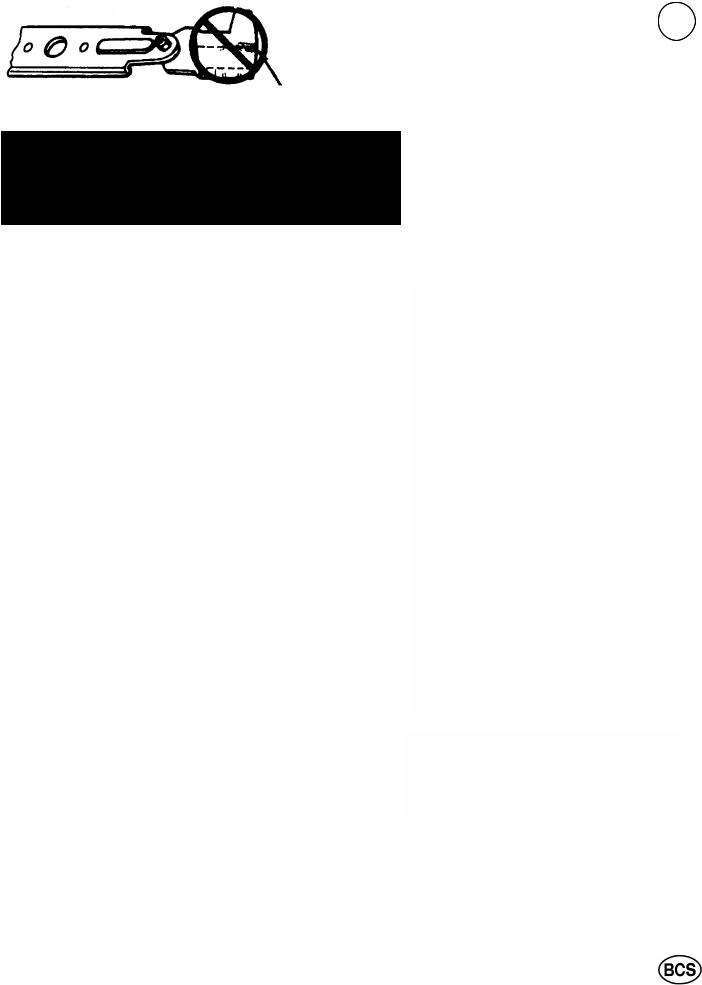
Don't operate the tiller in high gear. Don't use high transport speeds on slippery surfaces. When using a transport sulky, look behind and use care when backing.
ROTARY MOWER PRECAUTIONS
IMPORTANT NOTICE
Do not deactivate the PTO Reverse Lockout on any of the convertible models. The new design lock-outs on thee models automatically disengage during a conversion for frontmount attachments.
Clear the area to be mowed of all objects (wires, rocks, toys, etc.) which might be picked up and thrown by the mower.
Disengage the PTO and put the transmission into neutral (gear selector position "N") before cranking to start the engine and also whenever leaving the operator zone behind the handlebar or dismounting from a sulky. Stay alert for holes, rocks, roots in the terrain and other hidden hazards. Keep away from drop-offs. Use wheel extensions for added stability of a walk-behind mower. When walking behind, be especially cautions when changing direction on slopes.
When operating from a riding sulky, reduce speed and use extreme caution on slopes and in sharp turns to prevent tipping and loss of control.
MOW SLOPES AS FOLLOWS:
1.When riding, mow up and down, never across the slopes.
2.When walking behind, mow across the slopes, never up and down.
3.Do not mow excessively steep slopes.
Be careful not to discharge grass in direction of roadways, houses, vehicles and people. Inspect grass bags frequently for wear and deterioration. Replace grass bags which are not in good condition.
When the 2-blade mower is used without the grass bag, the grass deflector must be in the down position covering one discharge chute, and the door on the other chute must be closed to prevent open discharge from the chutes.
When mounting the grass bag on the deck to collect the cuttings, open the door and raise the deflector for discharge from the volutes into the bag.
Before removing the grass bag for emptying, disengage the PTO, shut off the engine and wait until the mower blades have stopped.
Never put hands in any openings of the mower or grass bag when the engine is running. If necessary to clear out the discharge chute with your hands, always first disconnect the spark plug wire.
Keep the mower blades in good condition. Inspect, sharpen and maintain blades as recommended for mower attachments in Section 3. Replace bent, badly worn blades, because pieces breaking off can become projectiles. After sharpening, blades should be balanced.
9
12
DO NOT MOW WITH GRASS DEFLECTORS OPEN
CRACKS

12
IMPORTANT NOTICE
Do not deactivate the PTO Reverse Lockout on any of the convertible models. The new design lockouts on these models automatically disengage during a conversion for front-mount attachments.
CUTTER BAR MOWER
PRECAUTIONS
Cutter Bar Mower attachments are intended for walk behind operation only. Do not use a riding sulky.
Mow only at a slow rate of speed. See page 39 for recommended throttle and gear combinations for cutter bar mowing. Do not use (transport) gear # 4 on 852 for any purpose other than using a transport sulky for transport. Transport speed of these models far exceeds the walking speed of an operator.
The models 718, 722, 732 and 948 converted for cutter bar operation have high gear position blocked by a high speed lockout.
Do not remove or otherwise defeat the purpose of the high speed lockout device.
Disengage the PTO when backing the machine.
Cutter bar mowers are designed for mowing over terrain which is too rugged or steep for use of rotary mowers. Use care when mowing hilly terrain. Always mow across the face of a slope, never up and down. Use wheel extenders for added stability. Do not mow excessively steep slopes. Go slowly and carefully on all turns.
SNOW THROWER
PRECAUTIONS
Wear protective trim fitting winter clothing with no scarf or draw strings which could be caught in the machinery. Wear boots or shoes designed to improve tour footing on slippery surfaces. Wear proper eye protection. When necessary to start the engine indoors and drive the machine out of the building, keep the doors and windows wide open. Exhaust fumes can be dangerous.
Never put your hands into the discharge opening or impeller/collector when the engine is running. Always disengage the PTO, shut off the engine and wait until all moving parts have stopped before doing the following:
1.Cleaning or deicing the impeller/collector and discharge chute (if possible, detach snow-thrower and thaw in a warm, dry place).
2.After striking a foreign object, thoroughly inspect for damage. Make repairs before further operation.
Never use the snow-thrower near glass enclosures, automobiles, window wells, drop-offs, etc., without adjusting the discharge angle away from them.
Keep children, pets and observers away.
10

21
POWER SPRAYER PRECAUTIONS
Always read and follow the information and instructions for the application of herbicides, fungicides, insecticides and fertilizer obtained from the labels of such products or from the manufacturer.
In addition, advice on chemicals approved for use in your area can be obtained from your local county agent. Be sure you know the proper application rate for any chemical you wish to spray.
Inspect the sprayer before each use. The sprayer develops high pressure so be sure all pressure lines and connections are in good condition.
Choose windless days for the spraying of any chemical considered hazardous. Do not spray where drift could contaminate people, animals or property.
When applying any substance dangerous if breathed in or absorbed through skin, wear adequate protection. This should include rubber gloves and boots, goggles, respirator masks, caps and clothing to cover as much as possible of the body. Cotton articles are suggested for their washable as well as high absorbency. After the spraying of any hazardous substance, remove clothing articles for laundering and immediately take a thorough soap-and- water shower before residues have time to enter your body.
Before spraying, always prepare for proper wash-down of equipment.
Never allow passengers to ride the sprayer.
The pressure at the discharge nozzle is as high as 300 psi. The spray can penetrate the skin and cause severe blood poisoning. Do not put hands into the discharge stream. Do not direct spray at people or animals.
Unless the manufacturer of the chemicals claims that certain products can be combined for application, spray only one chemical at a time. Flush the sprayer tank before changing sprays.
Always hose down the equipment and flush the sprayer tank after each use. Select an area where the run-off will not contaminate ground water. Do not dump into ditches and storm sewers.
11
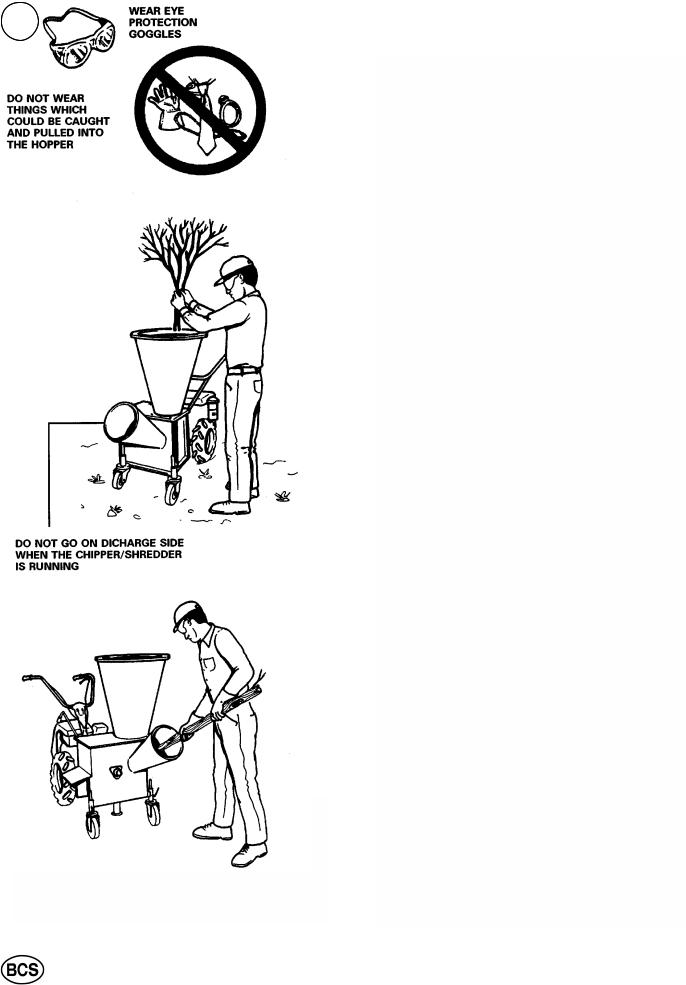
21
CHIPPER/SHREDDER PRECAUTIONS
Read all instructions in this owner's manual, plus detailed instructions in the Chipper/Shredder owner's manual.
Material may be thrown out of the intake or discharge openings at high velocity. Wear safety eye protection goggles stamped "Z87" (for ANSI Standard Z87). Also wear a hat.
Wear trim-fitting articles of clothing with no dangling ties laces, chains, etc. Remove rings, bracelets and wrist watches before operating the Chipper/Shredder. Gloves may be worn when feeding the Chipper but remove gloves before feeding material into the Shredder hopper.
Set up the machine on soft, firm ground which provides support and acts as a shock absorber. But, do not set up on hard paved or gravel surfaces which provide no cushion.
Before starting the engine, always look to be sure the Chipper/Shredder is empty.
Do not go on the discharge side when the Chipper/ Shredder is running. Do not look into the Shredder hopper or place your head over it when feeding material. Do not feed the chipper chute from directly in front but always stand to the side.
Do not reach into the chipper chute to push through short pieces. Push short ends through with another long branch.
Put only materials which can be shredded into the hopper.Be careful not to include cloth, string plastics, grass, rubber, rocks or paving, bricks, large wood chunks, metal or long branches or vines. These things cannot be shredded and can cause violet ejection of materials from the Chipper/Shredder.
Do not allow processed material to pile up in the discharge area. A blockage of the discharge can result in kickback of material through the feed opening.
Always disengage the PTO before transporting the unit and attachment. Never leave the machine unattended without putting the controls in neutral and disconnecting the spark plug wire to prevent unauthorized operations.
12

21
POWER SWEEPER PRECAUTIONS
Follow "General Precautions and Instructions" in Section One of this manual, and all instructions in the Power Sweeper Attachment owner's manual (part number 101.00915) for the safe use of the Power Sweeper.
IMPORTANT NOTICE
Deactivation of the PTO Reverse Lockout (see WARNING in Sweeper owner's manual) is not to be done on the tractor models in this updated owner's manual. New design lockouts automatically disengage during the conversion of these models for the Sweeper or any other front-mounted attachment.
Do not put hands, feet or any other part of your body near the sweeper brush or any other rotating part.
Keep the work area clear of people and pets. Do not let children come near. Be extremely careful on gravel or paved surfaces to direct the discharge away from people and passing vehicles.
Wear a dust mask or respirator for protection when sweeping dusty surfaces.
Wear eye protection goggles stamped "Z87" (for ANSI Standard Z87).
Before transport or storage of the unit adjust the casters of the sweeper so the bristles do not touch the ground.
Thoroughly inspect the surface to be swept and remove objects which could be thrown by the sweeper or cause it to run off course. Remove wires, glass objects, doormats, boards, toys and other obstructions.
Always put the unit in gear before engaging the PTO to power the sweeper. If the sweeper bristles engage the ground when the unit is in neutral, the sweeper will drive back the unit.
On irregular terrain with hillocks, prepare to let go of the controls to stop all motion if the brush suddenly drives the unit backward.
Do not use the sweeper on any surface where you cannot keep tour footing or the unit could overturn. Walk behind the unit. Disengage the PTO when going up or down a slope. Work across the slope when sweeping or thatching.
If using the sweeper on rooftops, set up barricades so you will not come too close to the edges. Be sure the surface is dry and does not pitch more than 5 degrees (1/2" per foot).
Do not drive the sweeper onto frozen lakes or ponds unless the ice is thick and strong enough to support the combined weight of you, the sweeper and the unit.
13

SECTION 2
SCHEME CONFIGURATIONS
|
NATURAL CONFIGURATION |
|
|
CONVERSE-MODE CONFIGURATION |
|
MODEL 852 / 853 |
|
MODEL 852 / 853 |
|
||
|
FRONT-MOUNT MODE |
|
|
CONVERSION FOR REAR-MOUNT ATTACHMENT |
|
|
|
|
|
|
|
|
|
|
|
|
|
|
|
|
|
|
|
MODELS 710/718/722/732 |
|
MODELS 710/718/722/732 |
|
||
|
REAR-MOUNT MODE |
|
|
CONVERSION FOR FRONT-MOUNT ATTACHMENT |
|
|
|
|
|
|
|
|
|
|
|
|
|
|
|
|
|
|
|
MODEL 948 |
|
MODEL 948 |
|
||
|
REAR-MOUNT MODE |
|
|
CONVERSION FOR FRONT-MOUNT ATTACHMENT |
|
TRASMISSION DESIGNED FOR |
|
|
|
|
|
REAR-MOUNT ATTACHMENTS |
|
|
CONTROL HANDLE |
|
|
|
|
|
|
TURNED 180° |
|
|
|
|
|
|
|
|
|
|
|
|
|
|
|
|
|
|
|
14

MODELS DESIGNED FOR |
2 |
|
FRONT-MOUNTED ATTACHMENTS |
||
|
Models of the 800 series are convertible model designed primarily as pusher for front-mount attachments, they have the PTO (power take-off) coupling up front, and the engine and control column at the rear.
852 has 4 speeds forward and 3 speeds reverse as pusher, 3 speeds forward and 3 speeds reverse as tractor. 853 has 3 speeds forward and 3 speeds reverse as pusher, but in rear-mount attachments (tractor) has 4 speeds forward and 3 speeds reverse.
Swinging the handlebars around to place them over the PTO coupling at the rear of the unit converts them for rear-mount attachments (tractor).
The transmission changes drive wheel rotation to drive the unit forward in either front-mount or rear-mount mode.
Selecting one of three available gear positions on the gear selector, and engaging the red reverser lever on the right handlebar backs up the unit in either frontmount or rear-mount mode.
The high speed lockout blocks selection of gear position #4 for backing up the units.
MODELS DESIGNED FOR
REAR-MOUNTED ATTACHMENTS
All models of the 700 series and 948 are designed for rear-mount tillers, and all models are convertible for front-mount attachments.
In the rear-mount mode, the PTO (power take-off) flange and the control column are at the rear and the engine is up front.
Models 710, 718, 722 and 732 have three speeds forward, two reverse.
Model 948 has four speeds forward, three reverse.
Swinging the control column around from the PTO end of the unit to the engine end converts it for front-mount attachments.
A safety high speed/reverse lockout device on the control column blocks the high forward speeds on 710, 718, 722, 732 and 948 which are too fast for use in backing the unit.
All models have a new type transmission that drives the unit forward when placed in gear-even when converted for front-mount attachments. In either front-drive or reardrive mode, selecting any gear except the high speed (that the lockout blocks) and moving the red reverser lever on the right handlebar backs up the unit. Gear #3 (#4 for 948) is too fast for backing up the unit.
15
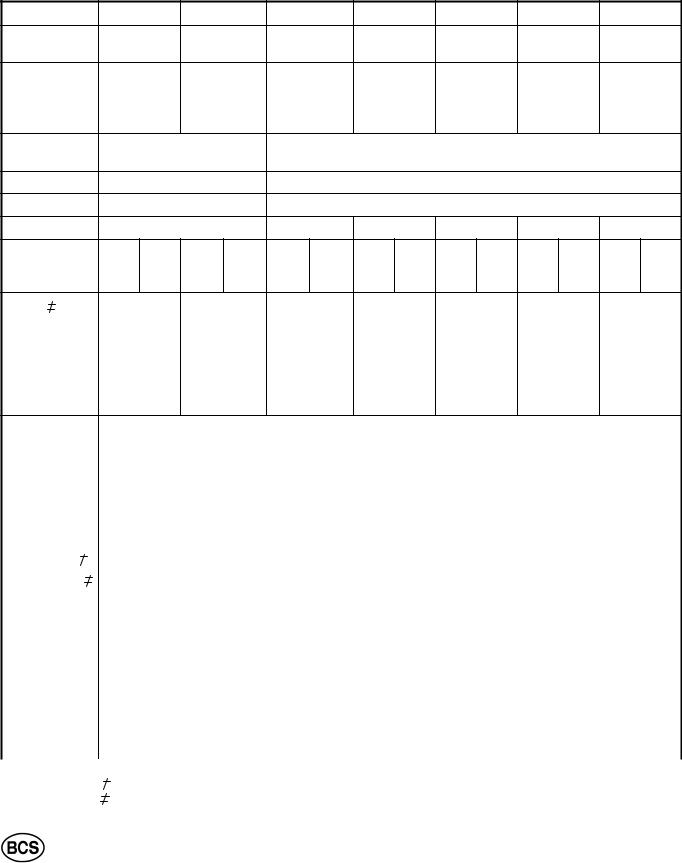
SPECIFICATIONS
ENGINE AND POWER UNIT
MODEL |
852 |
853 |
710 |
718 |
722 |
732 |
948 |
|||||||||
Design Type |
Pusher |
Pusher |
Tractor |
Tractor |
Tractor |
Tractor |
Tractor |
|||||||||
Convertible |
To Tractor |
To Tractor |
To pusher |
To pusher |
To pusher |
To pusher |
To pusher |
|||||||||
Engine |
|
HONDA |
HONDA |
Subaru SP170 |
|
|
|
|
HONDA |
|
|
|||||
|
|
|
|
|
GX340 carb. |
|
|
|||||||||
Make |
|
GX390 carb. |
GX390 carb. |
Subaru EX27 |
HONDA |
HONDA |
HONDA |
|||||||||
|
Subaru EX27 |
|||||||||||||||
Type |
|
or KOHLER |
or KOHLER |
Kohler CH270 |
GX200 carb. |
GX240 carb. |
GX390 carb. |
|||||||||
|
|
|
KD440 |
KD440 |
|
|
|
|
Kohler CH395 |
|
|
|||||
Type of air filter |
HONDA dry cartridge |
|
|
|
|
Dry cartridge |
|
|
|
|
||||||
|
KOHLER oil bath |
|
|
|
|
|
|
|
|
|
||||||
|
|
|
|
|
|
|
|
|
|
|
|
|||||
Prefilter |
|
|
Standard |
|
|
|
|
|
Standard |
|
|
|
|
|||
Transmission |
Precision steel gears |
|
|
|
Precision steel gears |
|
|
|
||||||||
Differential |
|
Yes |
|
No |
|
No |
No |
Yes |
Yes |
|||||||
Gears: |
|
Push. |
Tract. |
Push. |
Tract. |
Push. |
Tract. |
Push. |
Tract. |
Push. |
Tract. |
Push. |
Tract. |
Push. |
Tract. |
|
Forward |
|
4 |
3 |
3 |
4 |
2 |
3 |
2 |
3 |
2 |
3 |
2 |
3 |
3 |
4 |
|
Reverse |
|
3* |
3* |
3* |
3* |
2* |
2* |
2* |
2* |
2* |
2* |
2* |
2* |
3* |
3* |
|
Speed |
(mph) |
|
|
|
|
|
|
|
|
|
|
|
|
|
|
|
1st |
|
|
0.8 |
0.8 |
0.7 |
0.7 |
0.7 |
0.7 |
0.6 |
|||||||
2nd |
|
|
1.6 |
1.6 |
1.6 |
1.6 |
1.6 |
1.6 |
1.4 |
|||||||
3rd |
|
|
2.7 |
2.7 |
7.0 |
7.0 |
7.0 |
7.5 |
2.1 |
|||||||
4th |
|
|
8.3 |
8.3 |
- |
|
|
- |
|
- |
|
- |
6.5 |
|||
1st |
Reverse |
0.8 |
0.8 |
0.7 |
0.7 |
0.7 |
0.7 |
0.6 |
||||||||
2nd |
Reverse |
1.7 |
1.7 |
1.6 |
1.6 |
1.6 |
1.7 |
1.5 |
||||||||
3rd |
Reverse |
2.8 |
2.8 |
- |
|
|
- |
|
- |
|
- |
2.2 |
||||
Power take-off |
|
|
(independent – PTO rpm controlled by throttle setting on all models) |
|
||||
|
|
|
|
|
|
|
|
|
PTO rpm/ |
|
990 / 3600 |
990 / 3600 |
990 / 3600 |
990 / 3600 |
990 / 3600 |
990 / 3600 |
990 / 3600 |
Engine rpm |
|
|||||||
Attaching |
|
2 threaded |
2 threaded |
2 threaded |
2 threaded |
2 threaded |
2 threaded |
3 threaded |
Method |
studs w / nuts |
studs w / nuts |
studs w / nuts |
studs w / nuts |
studs w / nuts |
studs w / nuts |
studs w / nuts |
|
Wheels & Tires |
|
5.0 x 10” |
5.0 x 10” |
4.00 x 8” |
4.00 x 8” |
4.00 x 8” |
4.0 x 10” |
6.5 / 80 x 12” |
Size |
|
Tractor |
Tractor |
Tractor |
Tractor |
Tractor |
Tractor |
Tractor |
Tread |
|
|||||||
Track width |
|
20” |
20” |
17” |
17” |
17” |
19” |
26” |
Weight (lbs.) |
|
230 |
230 |
130 |
130 |
140 |
160 |
330 |
|
|
|
|
|
|
|
|
|
Dimensions (in.) |
|
|
|
|
|
|
|
|
Height |
|
47” |
47” |
40” |
40” |
40” |
40” |
34” - 43” |
Width |
|
27” |
27” |
25” |
25” |
25” |
25” |
27” |
Lenght |
|
47” |
47” |
63” |
63” |
63” |
63” |
78” |
|
|
|
|
|
|
|
|
|
Extra tires |
|
5.00-12 |
5.00-12 |
- |
- |
- |
- |
- |
|
|
|
|
|
|
|
|
|
Capacities (L) |
|
|
|
|
|
|
|
|
Transmission |
|
2.00 |
2.00 |
1.90 |
1.90 |
1.90 |
1.90 |
2.20 |
Crankcase |
|
1.10 |
1.10 |
0.60 |
0.60 |
1.10 |
1.10 |
1.10 |
Running time |
|
2 Hrs. |
2 Hrs. |
2 1/2 Hrs. |
2 1/2 Hrs. |
2 1/2 Hrs. |
2 1/2 Hrs. |
2 Hrs. |
@3000 rpm** |
|
|
|
|
|
|
|
|
NOTE: * |
Has “Reverser” control to change direction of travel. |
|
|
|
||||
|
|
May be adapted by mode of mounting wheels, or with optional accessories. |
|
|||||
|
|
Power unit with standard wheels and tires. |
|
|
|
|||
|
** |
at ¾ load. |
|
|
|
|
|
|
16
